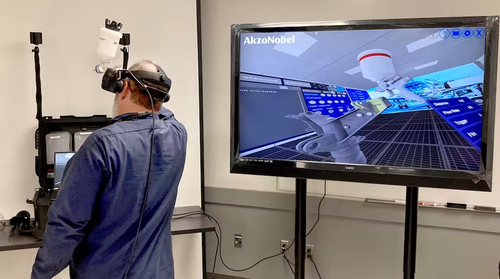THURSDAY, FEBRUARY 23, 2023
AkzoNobel Aerospace Coatings recently announced that it has teamed up with American Airlines to use virtual reality technology to deliver what the company calls a new way of training apprentice painters, as well as further educating existing teams.
About the VR Training System
Last year, AkzoNobel launched the new virtual reality training for painting aircraft at a National Business Aviation Association event. According to the release, the technology can mimic a customer’s production environment and multiple coating systems to train teams virtually and in a more sustainable and efficient way.
The VR-based system was developed by technology specialists Virtual Paint Products. It has also been successfully trialed at the company’s training center in Troy, Michigan. Since then, several portable units have reportedly been designed for use at a customer’s own premises.
AkzoNobel explains that the VR headset immerses the trainee in a virtual paint booth, with access to aircraft parts or larger-scale assemblies to the production floor itself. The system can then be programed with various paint specifications, such as the thickness of the coating required.
As the operator uses the virtual spray gun, they can reportedly see whether too much or too little paint is used and look for inconsistencies in the way the coating is being applied, the company says.

 |
| AkzoNobel Aerospace Coatings |
|
AkzoNobel Aerospace Coatings recently announced that it has teamed up with American Airlines to use virtual reality technology to deliver what the company calls a new way of training apprentice painters, as well as further educating existing teams. |
Through the training, the operator’s core skills, such as setting up the spraying session to the distance, angle, and speed at which the gun is used, are being measured. The feedback is reportedly immediate, allowing trainings to react quickly and change their technique.
The program will show where runs and sags occur, or where the wet film thickness is not sufficient or the coverage inadequate to deliver a smooth finish. Common paint problems such as paint overlap can also be seen, according to the company.
Airline Partnership
According to the emailed release, a nose landing gear cylinder of an aircraft was programmed into the system for American Airlines. Then, a group of 13 painters of varying abilities were encouraged to spray the part—but, AkzoNobel notes, without a single drop of real paint being used.
“In a spray booth, we’d have to spray the primer, then let it dry, then measure the results to see how they did—all of which takes time. If we were training 13 painters, we’d also have to have 13 nose landing gear cylinders available to paint,” said Terry Lesperance of American Airlines.
“With VR, we don’t have any of these challenges. I can train more painters, more quickly, and allow them to make mistakes without it costing me anything.”
Lesperance was reportedly supported by AkzoNobel’s Technical Services team for the training, suiting up and using the booth to share their experience and their technique with the Airlines’ new painters.
AkzoNobel further explains that there are other benefits to the technology. For example, a painter may have been using a polyurethane paint and need to switch to a Teflon paint or use a paint with a different mix that may be heavier or lighter. This can be programmed into the system to replicate the experience in a spray booth.
“Typically, when a customer asks for training, we have to provide significant quantities of paint, much of which is wasted,” said Matthew Amick, Global Technical Services Manager at AkzoNobel Aerospace Coatings.
“By effectively moving the spray booth into the classroom, we completely eliminate waste, reduce costs and unnecessary shipping, and prevent Volatile Organic Compounds (VOCs) from being released. There are also no costs associated with cleaning the spray guns, or the additional VOCs releases from the solvents required, or providing the panels needed for wet paint training. It’s a ‘win win’ for all involved.”
Lesperance added that he anticipates utilizing the VR system to train more of his team later this year.
Tagged categories: Aerospace; aircraft; AkzoNobel; Coating Application; Coatings education; Education; Paint application; Paint application equipment; Program/Project Management; Technology; Tools & Equipment; Worker training